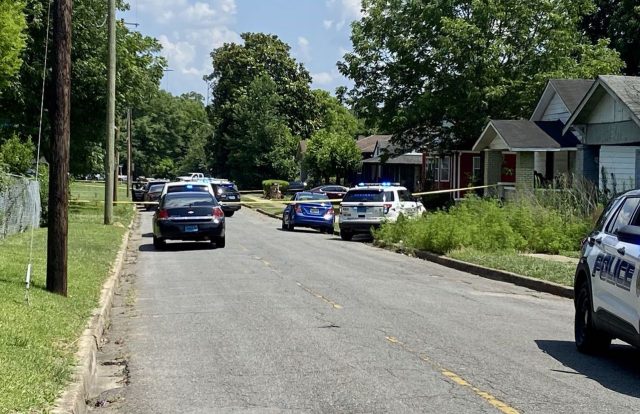
By Carol Robinson
AL.com
This is another installment in The Birmingham Times/AL.com/CBS42 joint series, “Beyond the Violence: What Can Be Done to Address Birmingham’s Rising Homicide Rate?” Click here to sign up for the newsletter.
Birmingham finished the first three quarters of 2023 with a double-digit percent decrease in homicides over the same time last year.
As of Sept. 30, Birmingham recorded 99 homicides. There were 112 homicides at the end of 2022′s third quarter.
That is about a 12 percent decrease from this time in 2022, a year that had the city’s highest number of homicides since 1991.
Of the homicides thus far in 2023, one was an officer-involved shooting by an outside law enforcement agency and seven others have been ruled justifiable and therefore aren’t deemed criminal.
In all of Jefferson County in 2023, there were 140 homicides from January through September, down from 150 at the same time last year.
There were 160 wounded in non-fatal shootings in the city, down from 262 during the first three quarters of 2022. That is a decrease of 40 percent.
“It’s a step in the right direction,’’ said Birmingham Police Chief Scott Thurmond. “It’s not what I would want. We still have a lot of work to do, but we’re moving in the right direction.”
The city ended 2022 with 144 homicides, the deadliest in recent history and only a few homicides short of being the deadliest in the Magic City’s entire history.
Birmingham police do not include justifiable homicides in their statistics because they are not required to send those to the FBI for nationwide analysis.
Police also do not include the officer-involved shooting by the Jefferson County Sheriff’s Office in their homicide numbers.
Homicides In Birmingham, By The Numbers:
Black males continue to account for the majority of the city’s homicide victims.
One white male, three Hispanic males and one Israeli citizen, according to BPD statistics.
Sixteen women have been killed — 15 of them Black. There were 19 women killed in the city in all of 2022.
Guns were used in 88 of the slayings.
Of the known weapons, 58 were handguns and 28 rifles. Two other victims died by blunt force trauma, and some of the weapons are still unknown.
The West Precinct – which has the largest coverage area of the city’s four police precincts – led in homicides with 32. East Precinct had 24, North Precinct, 23, and South Precinct, 11.
The majority of criminal homicides – 42 – took place between 3 p.m. and 11 p.m.
The day shift – 7 a.m. until 3 p.m. – saw 27 homicides and the morning shift – 11 p.m. until 7 a.m. – had 22 slayings.
In the majority of the homicides, motive remains unknown. Of those that are known, six people were killed during robberies, and five each were killed in a fight, a domestic incident or in revenge.
Homicides With Juvenile Victims Are Down
The leading cause of Birmingham’s killings is the lack of conflict resolution, which has become a buzz term in violent crime discussions in recent years.
“People can’t get along,’’ the chief said.
The number of juveniles killed so far this year has drastically decreased.
Six victims have been ages 17 and under. There were 13 juveniles killed in all of 2022.
“We had a fairly big number last year and that number is down fairly significantly,’’ Thurmond said.
The chief said he would like to think that parents are becoming more involved, and making sure they know where their children are and what they’re doing.
“I would hope that would be part of it,’’ he said.
Here’s a look at the other age demographics:
– Ages 18 to 29 – 39 victims
– Ages 30 to 49 – 42 victims
– Ages 50 and up – 11 victims
“The age of our victims is a bit higher this year,” Thurmond said. “That’s troubling because those people should have enough sense to be able to get along or walk away or deal with those conflicts in a different way other than pulling out a gun and shooting someone.”
“I think people get so mad, so angry, they pull out the gun, but they don’t realize the ultimate repercussions of destroying two families, someone losing their life,’’ he said. “Even in situation where someone doesn’t lose their life, you’ve got those permanently affected for the rest of their life.”
“They have lifelong injuries to deal with, not to mention the mental trauma,’’ he said. “That doesn’t get focused on as much.”
It’s hard to explain the ebb and flow of homicides, and there are rarely definitive answers as to what can cause them to fluctuate.
“Violent crime has been our focus this entire year,’’ Thurmond said. “It was our focus last year.”
Joint Efforts Across Jurisdictions
One of the bigger things, he said, is the joint effort between the Birmingham Police Department and other area law enforcement agencies on all levels regardless of jurisdictional boundaries.
“We’ve been working together to fight violent crime,’’ he said. “That’s a huge thing.”
He pointed to the Areyelle Yarbrough case. Yarbrough was killed in 2021 Easter Sunday shooting at Birmingham’s Patton Park that also left five others injured.
Police officials last month held a press conference to announce an arrest in the case. Leaders from numerous law enforcement agencies were in attendance.
“It’s not about who leads what organization,’’ Thurmond said. “It’s about that we’re all committed to each other to violent crime regardless of what agency we lead.”
“The sheriff (Mark Pettway) and I committed to each other early to work together,” Thurmond said. “We’re looking for the same criminals. We’re dealing with the same people.”
“We’re much effective when we combine our resources,’’ he said.
The chief pointed toward the Violent Crimes Task force and its work on the violent street gang H2K, which has expanded into investigating other groups and individuals as well.
“It’s a force multiplier,’’ he said.
He said Birmingham’s officers are committed to the mission.
“The men and women out there in uniform are putting in the work,’’ he said. “They’re working hard and that’s a huge piece as well.”
VIP2 at UAB
There are other things in the city that are affecting those numbers, he said, such as the year-long pilot program Violence Intervention and Prevention Partners, or VIP2, at UAB Hospital.
The program provides violence intervention specialists who assist in the delivery of case management services, including meeting with survivors of gun violence, providing connections to social, medical and mental health services and monitoring survivors’ progress over time.
“It’s hard to measure as far as numbers, but I would have to think they’re having some impact,’’ Thurmond said. “If they prevented one murder, then it was worth it.”
It’s often said that police can’t stop one person from shooting another. The hope is to stop it before it gets to that point.
“You don’t often see someone go straight to committing a homicide,’’ the chief said. “Maybe there was another shooting that took place, like shooting into a car or a home or even shooting someone, and it’s solving some of those crimes before they get a chance to escalate to a homicide.”
Thurmond said a vast number of homicide suspects were involved in domestic violence incidents before becoming a suspect in a homicide. That, he said, is another way to get ahead of the curve.
“If we can be more effective in dealing with those situations, then we can the trigger pullers off the street before it escalates to a homicide,’’ he said.
“There’s no way the Birmingham Police Department is going to prevent anyone from shooting someone else. If that’s their mindset, that’s going to be hard to do,’’ Thurmond said.
“But if we can get them off the streets from other crimes, they won’t have the opportunity to kill someone,’’ he said. Thurmond said investigators continue to focus on, and rely on, technology to help fight crime, such as the department’s Real Time Crime Center.
“Getting more cameras throughout the city, more technology for our officers,’’ he said.
‘Three Months Can Make Us Or Break Us’
The highest number of homicides recorded in Birmingham in recent memory before last year was 141 in 1991.
The city’s all-time annual record for homicides was set in 1933 recorded when Birmingham had 148 slayings.
The lowest ever recorded was 56 in 1966. Birmingham came close to that with just 57 homicides in 2011.
“I know we can get there, to those years where homicides got down in the 50s and 60s,’’ Thurmond said. “That would definitely be a goal of mine.”
He said he can’t predict how the homicide numbers will look by year’s end.
“I feel very positive right now, but things can change very quickly,’’ he said. “We’re just going to keep working hard and pushing hard with the initiatives that we’ve been doing to hopefully stay at the decrease we’re at now, if not more.”
“Maybe we’ve figured out a few things,’’ he said. “Time will tell.”
Thirty-two people were killed in the city in the fourth quarter of 2022.
“Three months can make us or break us,’’ Thurmond said. “Hopefully we will be way below that.”




